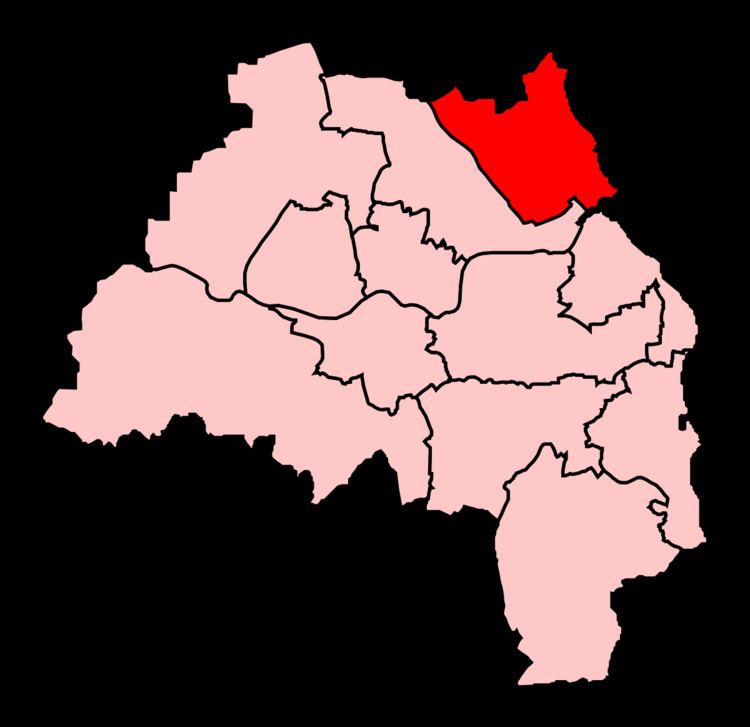Created 1885 Number of members One | Electorate 76,618 (December 2010) | |
 | ||
Major settlements | ||
Tynemouth is a constituency represented in the House of Commons of the UK Parliament since 1997 by Alan Campbell, a member of the Labour Party.
Contents
Boundaries
The seat covers Tynemouth, North Shields, Whitley Bay, Cullercoats, Monkseaton, and since 2010 Shiremoor and Backworth.
Since the May 2010 general election, the seat has electoral wards:
Pre-2010 the constituency did not include the Shiremoor and Backworth ward of 'Valley', instead including the Percy Main ward of 'Riverside'. This effectively meant the constituency stretched only as far north as Whitley Bay and Earsdon, while extending quite far along the north bank of the Tyne, touching the edge of Wallsend. The A19 road acted as a straight inland boundary in all instances.
History
The constituency was created under the Redistribution of Seats Act 1885.
The seat has historically shown the highest level of support for the Conservative Party in the Tyne and Wear area, with the Conservatives holding the seat from 1950 until 1997, though sometimes with small majorities. However, since the 1997 general election, it has been represented by a Labour MP.
The present member, Alan Campbell reached the level of government below a Minister of State in 2008, as a Parliamentary Under-Secretary of State for the Home Office.
Constituency profile
A coastal seat on the northern bank of the Tyne. North Shields and the communities along the Tyne itself tend to be more industrial and working class, once dominated by coal mining and shipbuilding. The coastal towns to the north, such as Whitley Bay, tend to be more middle class dormitory towns for Newcastle commuters.
This has tended to be one of the more Conservative seats in the Tory desert that is the North East. As a relatively middle class area it returned Conservative MPs from 1950 to 1997, albeit often on narrow majorities. It has been represented by Labour since 1997, though the Conservatives remain strong at a local level.
Workless claimants, registered jobseekers, were in November 2012 close to the national average of 3.8%, at 3.9% of the population based on a statistical compilation by The Guardian, lower than the regional average by 0.5%.
Members of Parliament
The Next Election
The Liberal Democrats selected North Heaton Councillor Greg Stone in 2016.
Elections in the 2010s
For the 2010 election, this was the primary target seat for the Conservatives in North East England following impressive local council victories since 2006 and the recent marginality of Alan Campbell's 2005 re-election.
Elections in the 2000s
With a local Whitley Bay councillor as their candidate, the Conservatives hoped to snatch the seat, but could only diminish Labour's Alan Campbell's majority. In the Mayoral election held on the same day, Mayor Linda Arkley (Conservative) also failed to be re-elected.
Labour MP Alan Campbell was returned in 2001 with smaller majority on the back of Tony Blair's second landslide.
Elections in the 1990s
In 1997 Labour won their largest Tynemouth majority ever. The Conservatives chose Gateshead Councillor Martin Callanan as their candidate to replace the retiring Neville Trotter. He would latterly become a North East MEP.
In 1992 Neville Trotter narrowly won his final term as the Labour candidate's fourth attempt failed. Many council seats were also unexpectedly won on the back of John Major's victory such as Whitley Bay and Monkseaton.
Elections in the 1980s
1983: Neville Trotter's biggest majority on the back of Mrs. Thatcher's landslide.
Elections in the 1970s
1979: Patrick 'Paddy' Cosgrove's first of four attempts to win the seat. Cosgrove was the Labour councillor for Whitley Bay Ward.
February 1974: Neville Trotter, a Newcastle City Councillor and Chartered Accountant, becomes MP.
1970: Jeremy Beecham would later become leader of Newcastle City Council and a Peer.
Elections in the 1960s
1966: Gordon Adam would latterly become a North East MEP and make a failed bid to become Elected Mayor of North Tyneside in 2001.
Elections in the 1910s
1918: Dixon Scott was the founder of Newcastle's 'News Cinema', the modern 'Tyneside Cinema'.
